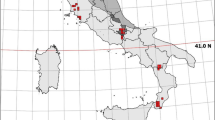Abstract
Cyclicity in behaviours, including reproduction, in relation to the lunar cycle is widely documented in some phyla, but weak or unknown in Class Mammalia. In this paper we present long-term video surveillance data of wild Eurasian badgers Meles meles, which reveal a strong correlation between reproductive behaviour and the lunar cycle. Squat marking and raised-leg urination, which increase in frequency at times of reproductive activity, showed maxima around day 22 of the lunar cycle (i.e. new moon). These findings were supported by observations of matings, together with published records, which showed significantly higher occurrence in the lunar dark phase (last quarter to first quarter). We propose that the lunar cycle has the potential to act as a regulator of the reproductive cycle in the badger.


Similar content being viewed by others
References
Bentley MG, Olive PJW, Last K (2001) Sexual satellites, moonlight and the nuptial dances of worms: the influence of the Moon on the reproduction of marine animals. Earth Moon Planets 85(6):67–84
Browne WJ, Ng ESW (2005) MCMC Estimation in MLwiN Version 2.0. Centre for Multilevel Modelling, University of Bristol
Browne WJ, Goldstein H, Rasbash J (2001) Multiple membership multiple classification (MMMC) models. Stat Model 1:103–124
Canivenc R, Bonnin-Laffargue M (1979) Delayed implantation is under environmental control in the badger (Meles meles). Nature 278:849–850
Cocks AH (1903) On the gestation in the badger. The Zoologist 7:441–443
Cocks AH (1904) The gestation of the badger. The Zoologist 8:108–114
Cresswell WJ, Harris S, Cheeseman CL, Mallinson PJ (1992) To breed or not to breed: an analysis of the social and density-dependent constraints on the fecundity of female badgers, Meles meles. Philos Trans R Soc B 338:393–407
Dixon DR (2003) A non-invasive technique for identifying individual badgers Meles meles. Mamm Rev 33:92–94
Domingo-Roura X, Macdonald DW, Roy MS, Marmi J, Terradas J, Woodroffe R, Burke T, Wayne RK (2003) Confirmation of low genetic diversity and multiple breeding females in a social group of Eurasian badgers from microsatellite and field data. Mol Ecol 12:533–539
Drabble P (1970) Aural evidence of spring mating in badgers (Meles meles). J Zool 162:547–548
Goldstein H (2003) Multilevel statistical models. Hodder Arnold, London
Gorman ML, Kruuk H, Leitch A (1984) Social functions of the subcaudal scent gland secretion of the European badger Meles meles (Carnivora: Mustelidae). J Zool 204:549–559
Kruuk H, Parish T (1982) Factors affecting population density, group size and territory size of the European badger Meles meles. J Zool 196:31–39
Kruuk H, Gorman ML, Leitch A (1984) Scent marking with the sub-caudal gland by the European badger Meles meles L. Anim Behav 32:899–907
Michiels NK, Hohner A, Vorndran IC (2001) Precopulatory mate assessment in relation to body size in the earthworm Lumbricus terrestris: avoidance of dangerous liaisons? Behav Ecol 12:612–618
Neal E (1948) The badger. New naturalist monograph, Collins, London
Neal E (1986) The natural history of the badger. Croom Helm, London
Neal E, Cheeseman C (1996) Badgers. T and A.D. Poyser, London
Neal E, Harrison R (1958) Reproduction in the European badger (Meles meles). Trans Zool Soc Lond 29:67–131
Owen C, Tarantello C, Jones M, Tennant C (1998) Lunar cycles and violent behaviour. Australian New Zealand Journal of Psychology 32:496–499
Paget RJ, Middleton ALV (1974) Badgers of Yorkshire and Humberside. The Ebor, York
Rasbash J, Goldstein H (1994) Efficient analysis of mixed hierarchical and crossed random structures using a multilevel model. J Educ Behav Stat 19:337–350
Rasbash J, Browne WJ, Healy M, Cameron B, Charlton C (2000) A user’s guide to MLwiN, 2nd edn. Institute of Education, London
Service KM, Harlow CM, Harris S (2002) Occurrence of monthly oestrous periods in badgers (Meles meles): a mechanism for observed variation in breeding patterns? Adv Ethol 37:149
Woodroffe R (1995) Body condition affects implantation date in the European badger, Meles meles. J Zool 236:183–188
Yalden DW (1999) The history of British mammals. Academic, London
Acknowledgements
We wish to thank N. Rendle and The Wrigley Company for generously supporting this study, and also to P. Dixon and R. McDonald for critically reviewing an earlier version of this manuscript. We are also grateful to an anonymous referee for their valuable comments.
Author information
Authors and Affiliations
Corresponding author
Additional information
Communicated by R. Oliveira
Rights and permissions
About this article
Cite this article
Dixon, D.R., Dixon, L.R.J., Bishop, J.D. et al. Lunar-related reproductive behaviour in the badger (Meles meles). acta ethol 9, 59–63 (2006). https://doi.org/10.1007/s10211-006-0016-4
Received:
Revised:
Accepted:
Published:
Issue Date:
DOI: https://doi.org/10.1007/s10211-006-0016-4




